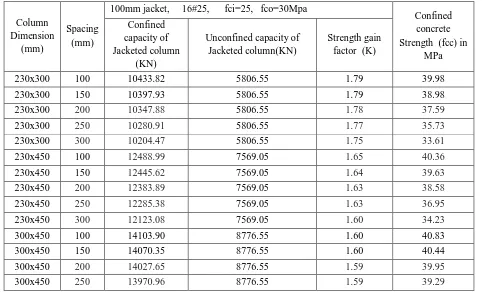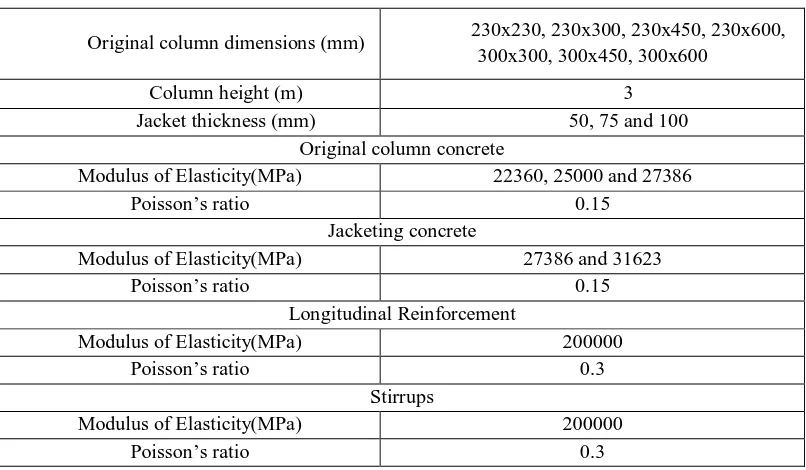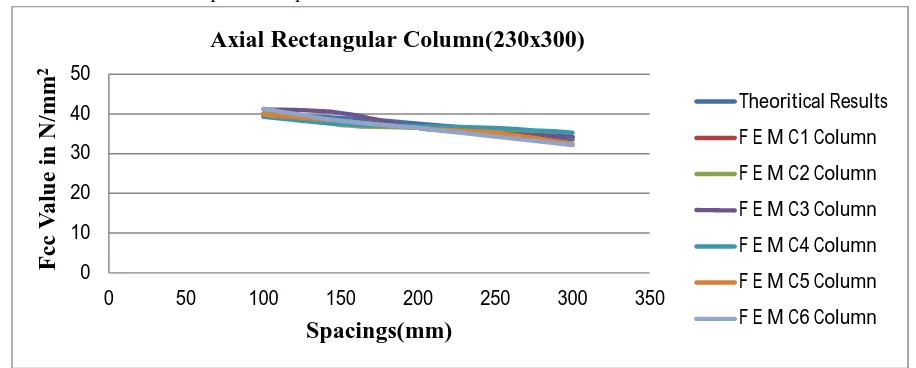Study on RC Jacketed Rectangular Column
under Axial load
Vijaya Kumar Y M1, Gopi Siddappa2, Suresh Chandra3,
1
Assistant professor, civil engineering, AIT Chikmagalur, Karnataka, India 2
Professor & H.O.D, civil engineering, P.E.S.C.E. Mandya, Karnataka, India 3
Pricipal , M R I T Mandya, Karnataka, India
Abstract: One strategy for the jacketing of reinforced concrete column is to target the improvement of local vulnerabilities in columns related to inadequate strength (compressive & Flexural) or poor ductility. Theoretical analysis have been carried out in the present study for different column sections of jacket thickness of 75mm and 100mm for jacketed RC columns subjected to axial compressive loading for rectangular column. The axial load carrying capacity along the major axes has been carried out under balanced section condition. Linear static finite element analysis has been carried out for the jacketed RC columns to compare the confined concrete strength (fcc) of finite element analysis with that of theoretical analysis, to plot the variation of stresses at the central core concrete and at the interface of old and new concrete. The displacements at core with respect to both major and minor axis are also plotted. Considerations have been given for variations in the properties of different types concretes used in the jacket and the original column. In order to find out the increase in the confined capacity of jacketed columns due to strengthening with respect to original column, theoretical analysis has been carried out.
Keywords: axial load, NISA Display IV, Jacketing, confined compressive strength.
I. INTRODUCTION
Reinforced concrete is a composite in which steel reinforcement bars ("rebar’s"), reinforcement grids, plates or fibers have been
incorporated to strengthen the concrete. It was invented by French Joseph Monier in 1849 and patented in 1867. The term Ferro Concrete refers to concrete that is reinforced with iron or steel. Other materials used to reinforce concrete are organic and inorganic fibers as well as composites in different forms. Concrete is strong in compression, but weak in tension, thus adding reinforcement increases its strength in tension. In addition, the failure strain of concrete in tension is so low that the reinforcement has to hold the cracked sections together.
II. OBJECTIVES OF THE PRESENT STUDY A. The Primary Objectives of the Present Study are
1) To find the confined and unconfined capacity of the jacketed RC columns subjected to axial load using the method based on Sheikh and Usurer’s model.
2) To obtain the strength gain factor K using the confined and unconfined capacity for Axial loaded columns for rectangular columns.
III. METHODOLOGY
Table 1: Dimensions of rectangular columns for Axial load (Both Theoretical and F E M Analysis)
A. Theoretical Analysis of Jacketed RC Axial Rectangular Columns
The method based on Sheikh and Usurer’s has been used for the theoretical analysis of jacketed RC column subjected to axial load.
[image:2.612.67.551.445.737.2]The grade of the original column concrete considered is 25MPa and that of jacket concrete are 30MPa. From below table it can be noticed that in case of rectangular columns of different dimensions the confined capacity of jacketed column, strength gain factor(k) and confined concrete strength (fcc) decreased considerably as the spacing of bars increased. In turn the unconfined capacity of jacket column remains constant irrespective of varied spacing and thickness of jacket.
Table 2: Comparison of axial compression component of original and jacketed column Type of
column Column Dimension Spacing
Percentage of steel Longitudinal Steel Provided Original
Column
Jacketed Column
Original column (number and diameter of main bars)
Jacketed column
(number and diameter of main
bars)
Rectangular Columns
230x230 100
2% gross area of original column
1% gross jacketed
area
8#20
8#16 230x300 150 4#16+8#12
300x450 200 12#12
300x600 250 16#25
450x600 300 12#25
Column Dimension
(mm)
Spacing (mm)
100mm jacket, 16#25, fci=25, fco=30Mpa
Confined concrete Strength (fcc) in
MPa Confined
capacity of Jacketed column
(KN)
Unconfined capacity of Jacketed column(KN)
Strength gain factor (K)
230x300 100 10433.82 5806.55 1.79 39.98 230x300 150 10397.93 5806.55 1.79 38.98 230x300 200 10347.88 5806.55 1.78 37.59
230x300 250 10280.91 5806.55 1.77 35.73
230x300 300 10204.47 5806.55 1.75 33.61
230x450 100 12488.99 7569.05 1.65 40.36
230x450 150 12445.62 7569.05 1.64 39.63
230x450 200 12383.89 7569.05 1.63 38.58
230x450 250 12285.38 7569.05 1.63 36.95
230x450 300 12123.08 7569.05 1.60 34.23
300x450 100 14103.90 8776.55 1.60 40.83 300x450 150 14070.35 8776.55 1.60 40.44 300x450 200 14027.65 8776.55 1.59 39.95
B. Finite Element Modeling
[image:3.612.120.523.305.540.2]Finite element modelling is described as the representative of the geometrical model in terms of a finite number of elements and nodes, which are the building blocks of the numerical representation of the model. In addition to information about elements and nodes, model also contains information about material and other properties, loading and boundary conditions. The most important step in the finite element method of structural analysis is to generate, using finite number of discrete elements, a mathematical model which should be as near as possible equivalent to the actual continuum. Such a formation of a model is referred to as structural idealization or discretization.The geometrical and material properties of the jacketed RC columns considered for analysis are given in below table.
Table 3: Geometrical and material properties
C. 3-d Models for Square and Rectangular column of Axial Loaded Column
Fig 1: Modelling of jacketed RC column Fig 2: Isometric view of normal stress distribution in the jacketed RC column 300x450 300 13893.71 8776.55 1.58 38.39
300x600 100 16599.18 10801.55 1.53 40.95
300x600 150 16560.77 10801.55 1.53 40.63
300x600 200 16512.67 10801.55 1.52 40.23
300x600 250 16448.98 10801.55 1.52 39.70
300x600 300 16360.53 10801.55 1.51 38.96
Original column dimensions (mm) 230x230, 230x300, 230x450, 230x600, 300x300, 300x450, 300x600
Column height (m) 3 Jacket thickness (mm) 50, 75 and 100
Original column concrete
Modulus of Elasticity(MPa) 22360, 25000 and 27386 Poisson’s ratio 0.15
Jacketing concrete
Modulus of Elasticity(MPa) 27386 and 31623 Poisson’s ratio 0.15
Longitudinal Reinforcement
Modulus of Elasticity(MPa) 200000 Poisson’s ratio 0.3
Stirrups
Table 4: FCC Results of Axial Loaded Rectangular Column
IV. RESULTS AND DISCUSSION
Due to confinement of core concrete by both inner and outer sets of stirrups, its original strength gets increased. In order to validate the theoretical results, the same has been compared with that of the finite element analysis results. The theoretical and finite element results obtained for the different column sections having different spacing of outer stirrups has been taken up for the comparison. The theoretical results obtained from the analysis of jacketed column of different thickness and varying concrete strength have been considered. That the results of theoretical and finite element analysis are approximately matching with some percentage of errors. Comparative errors are as shown in below graphs for with respect to theoretical analysis.
Graph 1: Comparison of Theoretical FCC Value to F E M FCC Value
0 10 20 30 40 50
0 50 100 150 200 250 300 350
F
cc
V
al
u
e
in
N
/m
m
2
Spacings(mm)
Axial Rectangular Column(230x300)
Theoritical Results
F E M C1 Column
F E M C2 Column
F E M C3 Column
F E M C4 Column
F E M C5 Column
F E M C6 Column
Column Section Spacing
Confined concrete strength (fcc) in MPa values
100mm jacket, 16#25, fci=25, fco=30Mpa
230x300 100 39.38
230x300 150 37.98
230x300 200 36.49
230x300 250 34.85
230x300 300 34.23
230x450 100 39.13
230x450 150 37.24
230x450 200 36.45
230x450 250 35.13
230x450 300 33.18
300x450 100 39.45
300x450 150 39.13
300x450 200 37.13
300x450 250 36.43
300x450 300 36.20
300x600 100 39.24
300x600 150 39.13
300x600 200 38.43
300x600 250 38.14
From the Above graph results of theoretical and finite element analysis are approximately matching with some percentage of errors. The percentage of errors is mentioned in the conclusion.
V. CONCLUSIONS
The object of investigation is to study the confined and unconfined capacity of jacketed R.C column. In turn to compare confined concrete strength by theoretical and F E M analysis. The conclusions are discussed in the respective chapters with results for all the aspects considered for study.
0 10 20 30 40 50
0 50 100 150 200 250 300 350
F cc V a lu es i n N /m m 2
Spacings(mm)
Axial Rectangular Column(230x450)
Theorical Results
F E M C1 Column
F E M C2 Column
F E M C3 Column
F E M C4 Column
F E M C5 Column
0 10 20 30 40 50
0 50 100 150 200 250 300 350
F
cc
V
al
u
es
i
n
N
/m
m
2Spacings(mm)
Axial Rectangular Column(300x450)
Theoritical Results
F E M C1 Column
F E M C2 Column
F E M C3 Column
F E M C4 Column
F E M C5 Column
F E M C6 Column
0 10 20 30 40 50
0 50 100 150 200 250 300 350
F
cc
V
al
u
es
i
n
N
/m
m
2Spacings(mm)
Axial Rectangular Column(300x600)
Theoritical Results
F E M C1 Column
F E M C2 Column
F E M C3 Column
F E M C4 Column
F E M C5 Column
A. R. C Jacketing can be considered for rehabilitation of column member. In which special design and construction techniques are not essential.
B. The K and fcc of axial loaded square and rectangle column will considerably decrease with increase in spacing of bars.
C. The theoretical and FEM analysis reveals that axial rectangular column the maximum error varied from positive 3.26 to negative 8.17.
REFERENCES
[1] Sheikh,S.A., and Uzumeri,S.M.(1982)."Analytical model for concrete confinement in tied columns”. Journal of the Structural Division.ASCE, 108(12), PP.
2703-2722
[2] J. B. Mander, M. J. N. Priestley, and R. Park: stress-strain model for concrete subjected to uniaxial compressive loading and confined by transverse
reinforcement. ASCE, Journal of structural Engineering, Vol.114, No. 8, August, 1988
[3] Bett et al (1988) “the effectiveness of three different repair and / or strengthening techniques in enhancing the lateral load and response of reinforced concrete
short columns”
[4] M.Frangou et al (1995) “Structural repair of RC columns construction and building materials,Vol.9 Jan 1995,PP.259-265.
[5] Husnii et al [1995] partially jacketed (Two, Three, Four sides) Reinforced Concrete Column Behaviour under Uni-Axial
[6] Indian standard Code of practice for plain and reinforced concrete (fourth revision), IS 456-2000, Bureau of Indian standard, July 2000, New Delh
[7] K.C.G. Ong, Y. C. Kog, C. H. Yu and A. P. V. Sreekanth,[2002] “Jacketing of reinforced concrete columns subjected to axial load”. National University of


